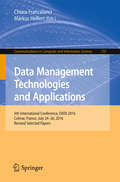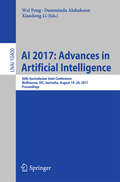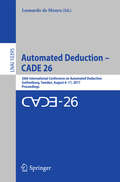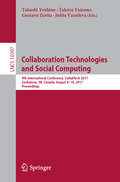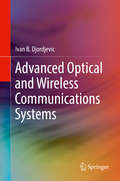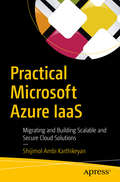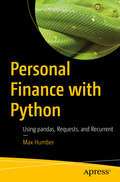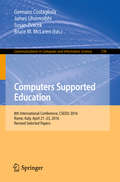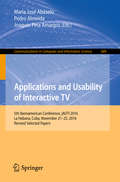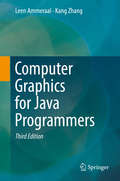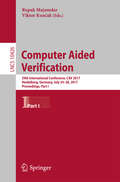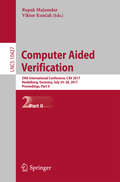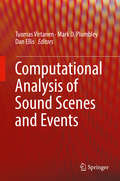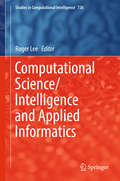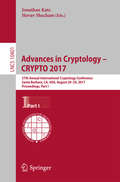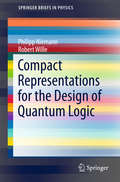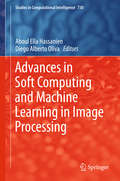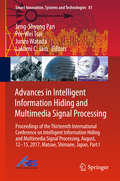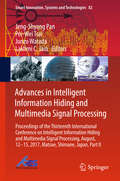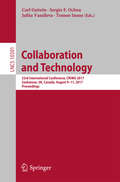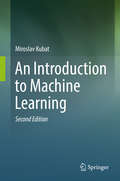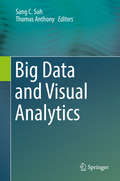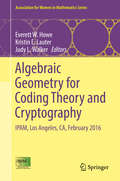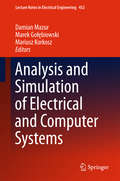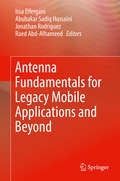- Table View
- List View
Data Management Technologies and Applications: 5th International Conference, DATA 2016, Colmar, France, July 24-26, 2016, Revised Selected Papers (Communications in Computer and Information Science #737)
by Markus Helfert Chiara FrancalanciThis book constitutes the thoroughly refereed proceedings of the Third International Conference on Data Technologies and Applications, DATA 2014, held in Vienna, Austria, in August 2014. The 12 revised full papers were carefully reviewed and selected from 87 submissions. The papers deal with the following topics: databases, data warehousing, data mining, data management, data security, knowledge and information systems and technologies; advanced application of data.
AI 2017: 30th Australasian Joint Conference, Melbourne, VIC, Australia, August 19–20, 2017, Proceedings (Lecture Notes in Computer Science #10400)
by Xiaodong Li Wei Peng Damminda AlahakoonThis book constitutes the refereed proceedings of the 30th Australasian Joint Conference on Artificial Intelligence, AI 2017, held in Melbourne, VIC, Australia, in August 2017. The 29 full papers were carefully reviewed and selected from 58 submissions. This volume covers a wide spectrum of research streams in artificial intelligence ranging from machine learning, optimization to big data science and their practical applications.
Automated Deduction – CADE 26: 26th International Conference on Automated Deduction, Gothenburg, Sweden, August 6–11, 2017, Proceedings (Lecture Notes in Computer Science #10395)
by Leonardo MouraThis book constitutes the proceeding of the 26th International Conference on Automated Deduction, CADE-26, held in Gothenburg, Sweden, in August 2017. The 26 full papers and 5 system descriptions presented were carefully reviewed and selected from 69 submissions. CADE is the major forum for the presentation of research in all aspects of automated deduction, including foundations, applications, implementations and practical experience. The chapter 'Certifying Confluence of Quasi-Decreasing Strongly Deterministic Conditional Term Rewrite Systems' is published open access under a CC BY 4. 0 license.
Collaboration Technologies and Social Computing: 9th International Conference, CollabTech 2017, Saskatoon, SK, Canada, August 8–10, 2017, Proceedings (Lecture Notes in Computer Science #10397)
by Julita Vassileva Takaya Yuizono Takashi Yoshino Gustavo ZuritaThis book constitutes the refereed proceedings of the 7th International Conference on Collaboration Technologies, CollabTech 2014, held in Santiago, Chile, in September 2014. The 10 revised full papers presented together with 4 short papers and a keynote were carefully reviewed and selected from 34 submissions. The papers are organized in topical sections on Collaborative Problem Solving; Knowledge Work and CSCW Tasks; Co-Dining Support; Augmented Reality and Robot; Learning Support Systems.
Advanced Optical and Wireless Communications Systems
by Ivan B. DjordjevicThis textbook introduces the advanced topics of: (i) wireless communications, (ii) free-space optical (FSO) communications, (iii) indoor optical wireless (IR) communications, and (iv) fiber-optics communications and presents these different types of communication systems in a unified fashion for better practical use. Fundamental concepts, such as propagation principles, modulation formats, channel coding, diversity principles, MIMO signal processing, multicarrier modulation, equalization, adaptive modulation and coding, detection principles, and software defined transmission are first described and then followed up with a detailed look at each particular system. The book is self-contained and structured to provide straightforward guidance to readers looking to capture fundamentals and gain theoretical and practical knowledge about wireless communications, optical communications, and fiber-optics communications, all which can be readily applied in studies, research, and practical applications. The textbook is intended for an upper undergraduate or graduate level course in optical communication. It features problems, an appendix with all background material needed, and homework.
Practical Microsoft Azure IaaS: Migrating And Building Scalable And Secure Cloud Solutions
by Shijimol Ambi KarthikeyanAdopt Azure IaaS and migrate your on-premise infrastructure partially or fully to Azure. This book provides practical solutions by following Microsoft’s design and best practice guidelines for building highly available, scalable, and secure solution stacks using Microsoft Azure IaaS. The author starts by giving an overview of Azure IaaS and its components: you’ll see the new aspects of Azure Resource Manager, storage in IaaS, and Azure networking. As such, you’ll cover design considerations for migration and implementation of infrastructure services, giving you practical skills to apply to your own projects. The next part of the book takes you through the different components of Azure IaaS that need to be included in a resilient architecture and how to set up a highly available infrastructure in Azure. The author focuses on the tools available for Azure IaaS automated provisioning and the different performance monitoring and fine-tuning options available for the platform. Finally, you’ll gain practical skills in Azure security and implementing Azure architectures.After reading Practical Microsoft Azure IaaS, you will have learned how to map the familiar on-premise architecture components to their cloud infrastructure counterparts. This book provides a focused and practical approach to designing solutions to be hosted in Azure IaaS.What You Will LearnMap the key Azure components to familiar concepts in infrastructure, such as virtualization, storage provisioning, switching, and firewallsImplement Azure IaaS deployment architectures Design IaaS environments in line with the Microsoft recommended best practices for scalability, resiliency, availability, performance, and securityManage the operational aspects of hosted environments, leverage automation, and fine tune for optimal performanceWho This Book Is ForInfrastructure and solution architects with skills in on-premise infrastructure design who want to up-skill in Azure IaaS.
Personal Finance with Python: Using Pandas, Requests, And Recurrent
by Max HumberDeal with data, build up financial formulas in code from scratch, and evaluate and think about money in your day-to-day life. This book is about Python and personal finance and how you can effectively mix the two together. In Personal Finance with Python you will learn Python and finance at the same time by creating a profit calculator, a currency converter, an amortization schedule, a budget, a portfolio rebalancer, and a purchase forecaster. Many of the examples use pandas, the main data manipulation tool in Python. Each chapter is hands-on, self-contained, and motivated by fun and interesting examples.Although this book assumes a minimal familiarity with programming and the Python language, if you don't have any, don't worry. Everything is built up piece-by-piece and the first chapters are conducted at a relaxed pace. You'll need Python 3.6 (or above) and all of the setup details are included.What You'll LearnWork with data in pandasCalculate Net Present Value and Internal Rate ReturnQuery a third-party API with RequestsManage secretsBuild efficient loopsParse English sentences with RecurrentWork with the YAML file formatFetch stock quotes and use Prophet to forecast the futureWho This Book Is ForAnyone interested in Python, personal finance, and/or both! This book is geared towards those who want to manage their money more effectively and to those who just want to learn or improve their Python.
Computers Supported Education: 8th International Conference, CSEDU 2016, Rome, Italy, April 21-23, 2016, Revised Selected Papers (Communications in Computer and Information Science #739)
by Susan Zvacek James Uhomoibhi Gennaro Costagliola Bruce M. MclarenThis book constitutes the thoroughly refereed proceedings of the 8th International Conference on Computer Supported Education, CSEDU 2016, held in Rome, Italy, in April 2016. The 29 revised full papers were carefully reviewed and selected from 164 submissions. The papers deal with the following topics: new educational environments, best practices and case studies of innovative technology-based learning strategies, institutional policies on computer-supported education including open and distance education.
Applications and Usability of Interactive TV: 5th Iberoamerican Conference, jAUTI 2016, La Habana, Cuba, November 21-25, 2016, Revised Selected Papers (Communications in Computer and Information Science #689)
by María José Abásolo Pedro Almeida Joaquín Pina AmargósThis book constitutes the refereed proceedings of the 5th Iberoamerican Conference on Applications and Usability of Interactive TV , jAUTI 2016, held in conjunction with the III International Congress on Information Engineering and Information Systems, in La Habana, Cuba, in November 2016. The 11 full papers presented were carefully reviewed and selected from 30 submissions. The papers are organized in topical sections on IDTV content production and recommendation; video consumption and preservation; social TV; IDTV interaction techniques; IDTV user experiences.
Computer Graphics for Java Programmers
by Leen Ammeraal Kang ZhangThis third edition covers fundamental concepts in creating and manipulating 2D and 3D graphical objects, including topics from classic graphics algorithms to color and shading models. It maintains the style of the two previous editions, teaching each graphics topic in a sequence of concepts, mathematics, algorithms, optimization techniques, and Java coding. Completely revised and updated according to years of classroom teaching, the third edition of this highly popular textbook contains a large number of ready-to-run Java programs and an algorithm animation and demonstration open-source software also in Java. It includes exercises and examples making it ideal for classroom use or self-study, and provides a perfect foundation for programming computer graphics using Java. Undergraduate and graduate students majoring specifically in computer science, computer engineering, electronic engineering, information systems, and related disciplines will use this textbook for their courses. Professionals and industrial practitioners who wish to learn and explore basic computer graphics techniques will also find this book a valuable resource.
Computer Aided Verification: 29th International Conference, CAV 2017, Heidelberg, Germany, July 24-28, 2017, Proceedings, Part I (Lecture Notes in Computer Science #10426)
by Rupak Majumdar Viktor KunčakThe two-volume set LNCS 10426 and LNCS 10427 constitutes the refereed proceedings of the 29th International Conference on Computer Aided Verification, CAV 2017, held in Heidelberg, Germany, in July 2017. The total of 50 full and 7 short papers presented together with 5 keynotes and tutorials in the proceedings was carefully reviewed and selected from 191 submissions. The CAV conference series is dedicated to the advancement of the theory and practice of computer-aided formal analysis of hardware and software systems. The conference covers the spectrum from theoretical results to concrete applications, with an emphasis on practical verification tools and the algorithms and techniques that are needed for their implementation.
Computer Aided Verification: 29th International Conference, CAV 2017, Heidelberg, Germany, July 24-28, 2017, Proceedings, Part II (Lecture Notes in Computer Science #10427)
by Rupak Majumdar Viktor KunčakThe two-volume set LNCS 10426 and LNCS 10427 constitutes the refereed proceedings of the 29th International Conference on Computer Aided Verification, CAV 2017, held in Heidelberg, Germany, in July 2017. The total of 50 full and 7 short papers presented together with 5 keynotes and tutorials in the proceedings was carefully reviewed and selected from 191 submissions. The CAV conference series is dedicated to the advancement of the theory and practice of computer-aided formal analysis of hardware and software systems. The conference covers the spectrum from theoretical results to concrete applications, with an emphasis on practical verification tools and the algorithms and techniques that are needed for their implementation.
Computational Analysis of Sound Scenes and Events
by Tuomas Virtanen Mark D. Plumbley Dan EllisThis book presents computational methods for extracting the useful information from audio signals, collecting the state of the art in the field of sound event and scene analysis. The authors cover the entire procedure for developing such methods, ranging from data acquisition and labeling, through the design of taxonomies used in the systems, to signal processing methods for feature extraction and machine learning methods for sound recognition. The book also covers advanced techniques for dealing with environmental variation and multiple overlapping sound sources, and taking advantage of multiple microphones or other modalities. The book gives examples of usage scenarios in large media databases, acoustic monitoring, bioacoustics, and context-aware devices. Graphical illustrations of sound signals and their spectrographic representations are presented, as well as block diagrams and pseudocode of algorithms.
Computational Science/Intelligence and Applied Informatics (Studies in Computational Intelligence #726)
by Roger LeeThis book presents the scientific outcome of the 4th ACIS International Conference on Computational Science/Intelligence & Applied Informatics (CSII 2017), which was held on July 9-13, 2017 in Hamamatsu, Japan. The aim of this conference was to bring together researchers and scientists, businessmen and entrepreneurs, teachers, engineers, computer users, and students to discuss the numerous fields of computer science, to share their experiences and to exchange new ideas and information in a meaningful way. The book includes research findings concerning all aspects (theory, applications and tools) of computer and information science, and discusses the practical challenges encountered and the solutions adopted to address them. The book features 16 of the conference's most promising papers, written by researchers who are expected to make significant contributions in the field of computer and information science.
Advances in Cryptology – CRYPTO 2017: 37th Annual International Cryptology Conference, Santa Barbara, CA, USA, August 20–24, 2017, Proceedings, Part I (Lecture Notes in Computer Science #10401)
by Jonathan Katz Hovav ShachamThe three volume-set, LNCS 10401, LNCS 10402, and LNCS 10403, constitutes the refereed proceedings of the 37th Annual International Cryptology Conference, CRYPTO 2017, held in Santa Barbara, CA, USA, in August 2017. The 72 revised full papers presented were carefully reviewed and selected from 311 submissions. The papers are organized in the following topical sections: functional encryption; foundations; two-party computation; bitcoin; multiparty computation; award papers; obfuscation; conditional disclosure of secrets; OT and ORAM; quantum; hash functions; lattices; signatures; block ciphers; authenticated encryption; public-key encryption, stream ciphers, lattice crypto; leakage and subversion; symmetric-key crypto, and real-world crypto.
Compact Representations for the Design of Quantum Logic (SpringerBriefs in Physics)
by Robert Wille Philipp NiemannThis book discusses modern approaches and challenges of computer-aided design (CAD) of quantum circuits with a view to providing compact representations of quantum functionality. Focusing on the issue of quantum functionality, it presents Quantum Multiple-Valued Decision Diagrams (QMDDs - a means of compactly and efficiently representing and manipulating quantum logic. For future quantum computers, going well beyond the size of present-day prototypes, the manual design of quantum circuits that realize a given (quantum) functionality on these devices is no longer an option. In order to keep up with the technological advances, methods need to be provided which, similar to the design and synthesis of conventional circuits, automatically generate a circuit description of the desired functionality. To this end, an efficient representation of the desired quantum functionality is of the essence. While straightforward representations are restricted due to their (exponentially) large matrix descriptions and other decision diagram-like structures for quantum logic suffer from not comprehensively supporting typical characteristics, QMDDs employ a decomposition scheme that more naturally models quantum systems. As a result, QMDDs explicitly support quantum-mechanical effects like phase shifts and are able to take more advantage of corresponding redundancies, thereby allowing a very compact representation of relevant quantum functionality composed of dozens of qubits. This provides the basis for the development of sophisticated design methods as shown for quantum circuit synthesis and verification.
Advances in Soft Computing and Machine Learning in Image Processing (Studies in Computational Intelligence #730)
by Aboul Ella Hassanien Diego Alberto OlivaThis book is a collection of the latest applications of methods from soft computing and machine learning in image processing. It explores different areas ranging from image segmentation to the object recognition using complex approaches, and includes the theory of the methodologies used to provide an overview of the application of these tools in image processing. The material has been compiled from a scientific perspective, and the book is primarily intended for undergraduate and postgraduate science, engineering, and computational mathematics students. It can also be used for courses on artificial intelligence, advanced image processing, and computational intelligence, and is a valuable resource for researchers in the evolutionary computation, artificial intelligence and image processing communities.
Advances in Intelligent Information Hiding and Multimedia Signal Processing: Proceedings of the Thirteenth International Conference on Intelligent Information Hiding and Multimedia Signal Processing, August, 12-15, 2017, Matsue, Shimane, Japan, Part I (Smart Innovation, Systems and Technologies #81)
by Junzo Watada Lakhmi C. Jain Jeng-Shyang Pan Pei-Wei TsaiThis volume of Smart Innovation, Systems and Technologies contains accepted papers presented in IIH-MSP-2016, the 12th International Conference on Intelligent Information Hiding and Multimedia Signal Processing. The conference this year was technically co-sponsored by Tainan Chapter of IEEE Signal Processing Society, Fujian University of Technology, Chaoyang University of Technology, Taiwan Association for Web Intelligence Consortium, Fujian Provincial Key Laboratory of Big Data Mining and Applications (Fujian University of Technology), and Harbin Institute of Technology Shenzhen Graduate School. IIH-MSP 2016 is held in 21-23, November, 2016 in Kaohsiung, Taiwan. The conference is an international forum for the researchers and professionals in all areas of information hiding and multimedia signal processing.
Advances in Intelligent Information Hiding and Multimedia Signal Processing: Proceedings of the Thirteenth International Conference on Intelligent Information Hiding and Multimedia Signal Processing, August, 12-15, 2017, Matsue, Shimane, Japan, Part II (Smart Innovation, Systems and Technologies #82)
by Junzo Watada Lakhmi C. Jain Jeng-Shyang Pan Pei-Wei TsaiThis volume of Smart Innovation, Systems and Technologies contains accepted papers presented in IIH-MSP-2016, the 12th International Conference on Intelligent Information Hiding and Multimedia Signal Processing. The conference this year was technically co-sponsored by Tainan Chapter of IEEE Signal Processing Society, Fujian University of Technology, Chaoyang University of Technology, Taiwan Association for Web Intelligence Consortium, Fujian Provincial Key Laboratory of Big Data Mining and Applications (Fujian University of Technology), and Harbin Institute of Technology Shenzhen Graduate School. IIH-MSP 2016 is held in 21-23, November, 2016 in Kaohsiung, Taiwan. The conference is an international forum for the researchers and professionals in all areas of information hiding and multimedia signal processing.
Collaboration and Technology: 23rd International Conference, CRIWG 2017, Saskatoon, SK, Canada, August 9-11, 2017, Proceedings (Lecture Notes in Computer Science #10391)
by Julita Vassileva Sergio F. Ochoa Tomoo Inoue Carl GutwinIt was approximately two decades ago that the support of communication and collaboration became an important research issue. The technical stimulation for this was the spread of personal computers and computer networks, whilst the social driver was the demand for the support of everyday work, frequently including group work and teamwork. This field of research has become known as Computer-Supported Cooperative Work whilst the systems to support group work are called groupware. Over the two decades, research has been extensively conducted. Various Web-based systems have been researched, some of which are aimed at the support of communication and collaboration. Mobile phones have spread rapidly and communication and collaboration support systems have also been researched on this platform. There are many other technologies such as virtual reality, robotics, multimedia, and ubiquitous computing, each of which provides opportunities for the research field. As the research field is not dependent on the type of technology, but is dependent on the needs of human activity and human beings are social animals, the technical demands of supporting social activities do not diminish. Technologies that potentially are useful for this purpose are being investigated whilst new technologies are invented. As a result of the development of IT, the research and development of communication and collaboration systems is increasingly active. The scope of this publication extends from perspectives, design principles, guidelines, and social aspects of communication and collaboration support systems to the various application systems and the platform technologies.
An Introduction to Machine Learning
by Miroslav KubatThis book presents basic ideas of machine learning in a way that is easy to understand, by providing hands-on practical advice, using simple examples, and motivating students with discussions of interesting applications. The main topics include Bayesian classifiers, nearest-neighbor classifiers, linear and polynomial classifiers, decision trees, neural networks, and support vector machines. Later chapters show how to combine these simple tools by way of "boosting," how to exploit them in more complicated domains, and how to deal with diverse advanced practical issues. One chapter is dedicated to the popular genetic algorithms.
Big Data and Visual Analytics
by Sang C. Suh Thomas AnthonyThis book provides users with cutting edge methods and technologies in the area of big data and visual analytics, as well as an insight to the big data and data analytics research conducted by world-renowned researchers in this field. The authors present comprehensive educational resources on big data and visual analytics covering state-of-the art techniques on data analytics, data and information visualization, and visual analytics. Each chapter covers specific topics related to big data and data analytics as virtual data machine, security of big data, big data applications, high performance computing cluster, and big data implementation techniques. Every chapter includes a description of an unique contribution to the area of big data and visual analytics. This book is a valuable resource for researchers and professionals working in the area of big data, data analytics, and information visualization. Advanced-level students studying computer science will also find this book helpful as a secondary textbook or reference.
Algebraic Geometry for Coding Theory and Cryptography: IPAM, Los Angeles, CA, February 2016 (Association for Women in Mathematics Series #9)
by Everett W. Howe Kristin E. Lauter Judy L. WalkerCovering topics in algebraic geometry, coding theory, and cryptography, this volume presents interdisciplinary group research completed for the February 2016 conference at the Institute for Pure and Applied Mathematics (IPAM) in cooperation with the Association for Women in Mathematics (AWM). The conference gathered research communities across disciplines to share ideas and problems in their fields and formed small research groups made up of graduate students, postdoctoral researchers, junior faculty, and group leaders who designed and led the projects. Peer reviewed and revised, each of this volume's five papers achieves the conference's goal of using algebraic geometry to address a problem in either coding theory or cryptography. Proposed variants of the McEliece cryptosystem based on different constructions of codes, constructions of locally recoverable codes from algebraic curves and surfaces, and algebraic approaches to the multicast network coding problem are only some of the topics covered in this volume. Researchers and graduate-level students interested in the interactions between algebraic geometry and both coding theory and cryptography will find this volume valuable.
Analysis and Simulation of Electrical and Computer Systems (Lecture Notes in Electrical Engineering #452)
by Damian Mazur Marek Gołębiowski Mariusz KorkoszThis book addresses selected topics in electrical engineering, electronics and mechatronics that have posed serious challenges for both the scientific and engineering communities in recent years. The topics covered range from mathematical models of electrical and electronic components and systems, to simulation tools implemented for their analysis and further developments; and from multidisciplinary optimization, signal processing methods and numerical results, to control and diagnostic techniques. By bridging theory and practice in the modeling, design and optimization of electrical, electromechanical and electronic systems, and by adopting a multidisciplinary perspective, the book provides researchers and practitioners with timely and extensive information on the state of the art in the field - and a source of new, exciting ideas for further developments and collaborations.
Antenna Fundamentals for Legacy Mobile Applications and Beyond
by Jonathan Rodriguez Issa Elfergani Abubakar Sadiq Hussaini Raed Abd-AlhameedThis book highlights technology trends and challenges that trace the evolution of antenna design, starting from 3rd generation phones and moving towards the latest release of LTE-A. The authors explore how the simple monopole and whip antenna from the GSM years have evolved towards what we have today, an antenna design that is compact, multi-band in nature and caters to multiple elements on the same patch to provide high throughput connectivity. The scope of the book targets a broad range of subjects, including the microstrip antenna, PIFA antenna, and the monopole antenna to be used for different applications over three different mobile generations. Beyond that, the authors take a step into the future and look at antenna requirements for 5G communications, which already has the 5G drive in place with prominent scenarios and use-cases emerging. They examine these, and put in place the challenges that lie ahead for antenna design, particularly in mm-Wave design. The book provides a reference for practicing engineers and under/post graduate students working in this field.
